
Lab Has Major Impact on Local, Global Economies
Fleming Steps Down as Deputy Director: Leaves Legacy of Scientific Innovation
Lab Has Major Impact on Local, Global Economies
Berkeley Lab generates $186 million annually in the city of Berkeley’s economy and almost $1.4 billion annually worldwide, according to an analysis of the Lab’s spending impacts unveiled earlier this month.
 Photo by Roy Kaltschmidt, CSO
Photo by Roy Kaltschmidt, CSO
The 18-page Economic Impact Study, which updates analyses conducted in 2001 and 1996, uses fiscal year 2004-2005 data to determine the Lab’s economic impacts on an ever-widening circle of regions. The report found that the Lab created $186 million in spending in the City of Berkeley, $682 million in the Bay Area’s nine counties, $799 million in California, and approximately $1.39 billion in the U.S. and international economies.
“Berkeley Lab’s substantial economic benefit for the local community and the region is greater than ever,” says Lab Director Steve Chu. “Berkeley Lab looks forward to continuing its strong regional partnerships with business and industry for our mutual economic benefit as it addresses the world’s scientific and technological challenges.”
The Facilities Division funded the study in conjunction with its development of the Lab’s 2006 Long Range Development Plan. It was conducted with assistance from CBRE Consulting, and was managed by the Public Affairs Office with assistance from the Office of the Chief Financial Officer, the Budget Office, and Human Resources.
The study uses a well-established economic impact model that takes into account the Lab’s direct spending on salaries and wages, goods and services, and construction. It then calculates how these expenditures pulse through various economies, local and beyond. For example, Lab employees spend their salaries at local businesses. In turn, these businesses use this income to purchase goods and services and to hire employees, who then spend their wages in the local economy. These various multipliers, as economists call them, account for the fact that for each one dollar the Lab spends, it generates an additional 69 cents in personal income.
In this way, Berkeley Lab’s direct spending of $104.4 million in the City of Berkeley induced an additional $81.6 million of spending in the city, for a total influx of $186 million to Berkeley’s economy thanks to the Lab’s presence.
The Lab’s spending created 593 additional jobs in the City of Berkeley, which in turn generated another 977 “indirect and induced” jobs, for a total of 1,570 jobs attributable to the Lab. Globally, the Lab generated more than 11,700 direct, indirect, and induced jobs.
Technology transfer also yielded big benefits. The Lab’s technology has formed the basis for more than 20 startups since 1990, whose market capitalization grew to over $2.5 billion by 2006. In addition, approximately 1,000 new jobs have been created in these companies alone.
The technologies licensed by these start-ups reflect the mission of a national lab to tackle society’s most difficult problems in medicine, energy, and the environment. They include genomics-related software, nanotechnology, drug development, x-ray imaging, materials sciences processing, biomolecular tagging, and energy-efficiency home improvements.
Additionally, licensing income to the Lab from new technologies grew from less than $500,000 in 1997 to more than $2.5 million in 2005. Approximately $800,000 of this licensing income was returned to inventors.
The report’s impressive numbers may be on the conservative side because it didn’t take into account the four major buildings that are planned for construction at the Lab over the next five years. These projects, plus the demolition of the Bevatron, are estimated at $360 million in costs and will translate into building industry and supply contracts as well as job opportunities and regional economic growth. The report also didn’t include the spending by the 2,500 guest researchers who visit the Lab annually. The study is available online at www.lbl.gov/Community.
Fleming Steps Down as Deputy Director: Leaves Legacy of Scientific Innovation
On Nov. 16, Berkeley Lab Director Steve Chu announced that the Lab’s Deputy Director, Graham Fleming, would step down from that position effective Dec. 1, to take “a long overdue and well-earned sabbatical.” Fleming, who has served as Deputy Director since July, 2005, will take an eight-month sabbatical starting the first of the new year, then return to continue his research as a scientist holding joint appointments with the Lab’s Physical Biosciences Division and with the UC Berkeley Chemistry Department as the Melvin Calvin Distinguished Professor of Chemistry. Following is a recap of his relatively brief but extraordinarily accomplished tenure.
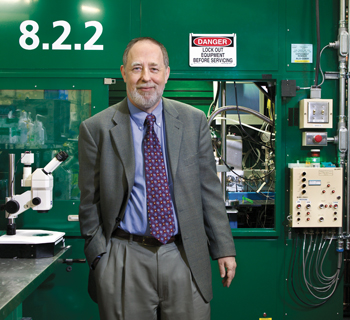 Photo by Roy Kaltschmidt, CSO.
Photo by Roy Kaltschmidt, CSO.
In November of 2004, the announcement that Berkeley Lab Deputy Director Pier Oddone, a 30-year veteran of the Laboratory, would be the next director of Fermilab, signaled a complete change in the Lab’s top scientific leadership. Just three months before, Steve Chu, a newcomer to Berkeley Lab and the national laboratory system, had assumed the director’s reigns after 15 years of Chuck Shank at the helm. To provide the institutional knowledge and experience that would help transition the Laboratory into a new era where alternative energy research would be a major focus, Director Chu, in March, 2005, chose Graham Fleming as the Lab’s new Deputy Director.
Fleming was an internationally known physical chemist, widely recognized as one of the world’s foremost authorities on ultrafast spectroscopy, when he came here in 1997 from the University of Chicago, where he’d been the Arthur Holly Compton Distinguished Service Professor. By 2004 he had already made a name for himself within both the Department of Energy and the UC systems. For Berkeley Lab, he created the Physical Biosciences Division (PBD) and served as its first director. As envisioned by Fleming, PBD was to integrate the techniques and concepts of the physical sciences and engineering disciplines into the study of biological systems. To facilitate this, he organized PBD to make it easier for scientists from different disciplines, but with complementary objectives, to work together.
Under his leadership, PBD grew to a staff of more than 400 members, and major initiatives were successfully launched in the microscopies of molecular machines, metabolomics and macromolecular dynamics. As PBD division director, Fleming also established the world’s first Synthetic Biology Department, with the aim of creating biologically-inspired systems that can solve problems natural biological systems cannot.
For UC, Fleming was one of the principal organizers and visionaries behind QB3 — the California Institute for Quantitative Biomedical Research — a consortium consisting of researchers at the UC campuses of Berkeley, San Francisco and Santa Cruz. In 2000, Fleming was named co-director of QB3 (a leadership position he retains) whose mission is to tackle complex biological problems through the use of state, federal and private resources, and the powerful quantitative tools of the physical sciences, engineering and mathematics. He was also one of the proponents behind the new Stanley Biosciences and Bioengine-ering Building, the first building on the UC Berkeley campus not “owned” by a College or Department, but devoted to bringing together programs in the physical, engineering and biological sciences.
In 2002, Fleming was named Berkeley Lab’s Associate Laboratory Director for Physical Sciences. In keeping with the spirit of Lab founder Ernest Lawrence, he took significant steps towards integrating many of the research programs within the four divisions under his purview — Physical Biosciences, the Advanced Light Source, Materials Sciences and Chemical Sciences. Under his watch the ALS substantially increased its beamlines and number of users, and ground was broken for the Molecular Foundry.
As Berkeley Lab’s Deputy Director, Fleming has been a key player in Director Chu’s efforts to refocus and broaden the Lab’s research in the production of renewable, clean energy. Fleming led the formulation of the biofuels component of the Helios solar energy project, which became the basis for the multi-institutional partnership called the Joint Bioenergy Institute (JBEI). With Fleming as one of its most ardent champions, JBEI was selected by DOE as one of three $135 million Bioenergy Research Centers. Fleming was also instrumental in developing the proposal that eventually became the Energy Biosciences Institute (EBI), a $500 million grant from BP to a collaboration that includes Berkeley Lab, UC Berkeley and the University of Illinois at Urbana-Champaign. Most recently he co-chaired the Grand Challenges project for DOE’s Office of Basic Energy Sciences, which laid out a roadmap for acquiring knowledge in five critical areas needed to direct and control matter and energy at the quantum level. In between addressing these issues of national concern, he helped make the scientific and technical case for the Laboratory’s next-generation light source proposal, initiated and implemented a complete revision of the Lab’s hiring and promotion policies for scientists and engineers, and proposed and helped establish the Seaborg Fellows program.
Throughout all of his administrative efforts, Fleming continued to lead a world-class research effort into the photosynthetic process, with the ultimate goal of developing an artificial version that can provide humanity with clean, efficient and sustainable energy. This past summer he made headlines with the discovery that quantum mechanical effects are behind the nearly 100-percent efficiency by which green plants and cyanobacteria are able to convert sunlight into chemical energy. This resaerch was cited by both Scientific American and Discover magazine as one of the year’s best stories in science.
In his announcement that Fleming was stepping down as Deputy Director, Chu said, “As an administrator, Graham helped establish a new era in Lab-UC Berkeley campus relations by leading a number of Lab-campus working groups to increase collaborations between the two organizations. As an internationally prominent biochemist, he helped raise the scientific standard across the Lab, as evidenced in the quality of appointments, and in the breadth and scope of the many research proposals and new collaborations. As a result of his hard work, Berkeley Lab is a stronger institute, and is well-positioned to compete for future DOE initiatives. In the years I have interacted with Graham, I have learned a great deal from him.”
Reception Honors Laboratory 2007 Peace Prize Laureates
Berkeley Lab energy analyst Jayant Sathaye recalled back in 1990 when he was asked to attend an early meeting of something called the International Panel on Climate Change. “It made no sense for me to go,” he said. “I didn’t know why I was invited.”
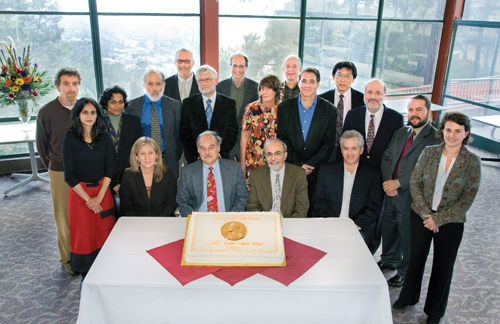 Back row: John Busch, Curt Oldenburg, Karsten Preuss. Next row: Steve Meyers, Lee Schipper, Phil Haves, Mithra Moezzi, Joe Huang. Next Row (standing): Surabi Menon, Maithili Iyer, Norm Miller, Ed Vine, Evan Mills, Stephane de la Rue du Can. Seated: Lynn Price, Mark Levine, Jayant Sathaye, Bill Collins.
Back row: John Busch, Curt Oldenburg, Karsten Preuss. Next row: Steve Meyers, Lee Schipper, Phil Haves, Mithra Moezzi, Joe Huang. Next Row (standing): Surabi Menon, Maithili Iyer, Norm Miller, Ed Vine, Evan Mills, Stephane de la Rue du Can. Seated: Lynn Price, Mark Levine, Jayant Sathaye, Bill Collins.
Now he knows. His contributions to the IPCC, and those of 21 colleagues at Berkeley Lab, were honored recently along with over 2,000 authors, editors and researchers with the collective Nobel Peace Prize, which they shared with politician-environmentalist Al Gore.
The group accepted the congratulations of Lab Director Steve Chu, himself a member of the Nobel society, at a Dec. 3 gathering at the cafeteria. Two large cakes with the Nobel medal emblazoned in the icing were consumed, as members of the Environmental Energy Technologies and Earth Sciences divisions — homes to the honored scientists — returned Chu’s sparkling-cider toast.
“This is a great honor,” he told them. It (the IPCC) is one of the substantive reports that I go to (for reference), and I hope policymakers will continue to do so. I believe (climate change) will be the most pressing problem in science, technology and policy in the coming decades.”
The series of IPCC reports over the last 17 years created an ever-broader informed consensus about the connection between human activities and global warming. They served to disseminate greater knowledge about man-made climate change and to lay the foundations for the measures that are needed to counteract such change. They presented more evidence than ever before that extensive climate changes may alter and threaten the living conditions of much of mankind.
 From left, Francesca, Nathanial, and Sasha Mills help their father Evan celebrate the awarding of the Peace Prize.
From left, Francesca, Nathanial, and Sasha Mills help their father Evan celebrate the awarding of the Peace Prize.
Photos by Roy Kaltschmidt, CSO
Berkeley Lab’s distinguished team of contributors includes coordinating lead authors Sathaye and Mark Levine (EETD), lead authors Bill Collins (ESD) and Lynn Price (EETD), and the following colleagues: EETD — Ed Vine, Evan Mills, Ernst Worrell, Hashem Akbari, John Busch, Mithra Moezzi, Lee Schipper, Laura Van Wie McGrory, Maithili Iyer, Phil Haves, Stephane de la Rue du Can, Steve Meyers, Subari Menon, Joe Huang, and Willie Makundi; ESD – Curt Oldenburg, Inez Fung, Karsten Pruess, Norm Miller, and Sally Benson (now at Stanford).
The value of the IPCC, according to Levine, was as “an institution that is highly credible, existing over a long period of time, building upon past work, and able to speak to the leaders of the world. The IPCC did this, and it was a remarkable achievement.”
Price, who has been working with the IPCC since 1994, said the Nobel announcement caught her totally by surprise, via a 5 a.m. e-mail at home. She gave special mention to division assistant Barbara Adams for her administrative help and to her husband and son, “for putting up with the long hours and the travel.”
She added, “I feel very grateful to be working at Berkeley Lab and to make a small contribution to this international effort.”
And Collins, who is relatively new to the Lab, called the award “not an ending, but a beginning…for the scientific community to address these problems and achieve sensible, technically solid solutions to climate change. The award is a propellant to move us into action.”
‘Green Corridor’ Partners to Make East Bay Center for Green Economy
With apologies to Tulane University’s athletic mascot, the East Bay plans to hop on the “green wave” to an energy-efficient economy. That’s what six of the region’s political and institutional leaders have pledged in establishing the “Green Corridor,” a symbolic district of promise for support of emerging green and sustainable industries, alternative energy research, and a healthy environment.
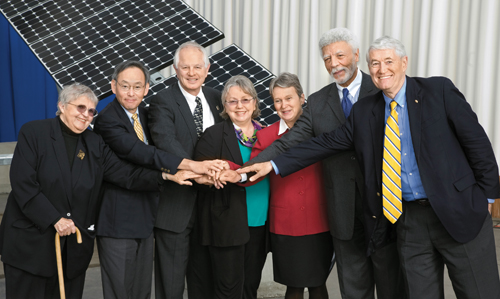 All for one: the “green corridor” partners from left — Emeryville Council member Nora Davis; Berkeley Lab Director Steve Chu; Berkeley Mayor Tom Bates; Richmond Mayor Gayle McLaughlin; Assemblywoman Loni Hancock; Oakland Mayor Ron Dellums; and UC Chancellor Bob Birgeneau.
All for one: the “green corridor” partners from left — Emeryville Council member Nora Davis; Berkeley Lab Director Steve Chu; Berkeley Mayor Tom Bates; Richmond Mayor Gayle McLaughlin; Assemblywoman Loni Hancock; Oakland Mayor Ron Dellums; and UC Chancellor Bob Birgeneau.
Berkeley Mayor Tom Bates had the most quotable sound bites at a ceremony in Richmond on Dec. 3 that established the collaboration via a “statement of principals.” In addition to his commitment to “catch the green wave, and all of us are going to be on the boat,” he said he envisioned the East Bay as “the Silicon Valley of the green economy.”
Berkeley Lab Director Steve Chu and Berkeley campus Chancellor Bob Birgeneau are on board, offering the technical expertise and building a center of alternative energy research that will have no equals. “We have UC Berkeley and our Lab to drive the intellectual engine that can fuel leadership in the East Bay for addressing climate change,” Chu told the 200 witnesses to the birth of this new compact.
The event was appropriately held in the new location for SunPower, a leader in solar technology, in a warehouse in Richmond where Ford Model A’s were assembled four decades ago. It is companies like this, and like Seeo, a startup for energy storage technology established by former Berkeley Lab scientist Elan Gur, that will establish the economics roots from which the green revolution will grow.
“Bringing together the resources of the region in support of local governments will create something truly remarkable,” Gur said. “We want to take advantage of the incredible resources in the East Bay.”
Mayors Ron Dellums of Oakland and Gayle McLaughlin of Richmond both emphasized how developing the green economy will result in job training and career opportunities for disadvantaged citizens in the region. And Council member Nora Davis of Emeryville said the East Bay will be the center of “a true post-industrial revolution” in developing a green economy.
Their collective actions will include an annual Green Summit to review progress and set future agendas, quarterly economic and workforce development meetings, and a regional green job training and placement effort. The partners will also work jointly to identify and seek federal funding in support of new energy programs.
Berkeley Lab View
Published once a month by the Communications Department for the employees and retirees of Berkeley Lab.
Reid Edwards, Public Affairs Department head
Ron Kolb, Communications Department head
EDITOR
Pamela Patterson, 486-4045, [email protected]
Associate editor
Lyn Hunter, 486-4698, [email protected]
STAFF WRITERS
Dan Krotz, 486-4019
Paul Preuss, 486-6249
Lynn Yarris, 486-5375
CONTRIBUTING WRITERS
Ucilia Wang, 495-2402
Allan Chen, 486-4210
David Gilbert, (925) 296-5643
DESIGN
Caitlin Youngquist, 486-4020
Creative Services Office
Berkeley Lab
Communications Department
MS 65, One Cyclotron Road, Berkeley CA 94720
(510) 486-5771
Fax: (510) 486-6641
Berkeley Lab is managed by the University of California for the U.S. Department of Energy.
Online Version
The full text and photographs of each edition of The View, as well as the Currents archive going back to 1994, are published online on the Berkeley Lab website under “Publications” in the A-Z Index. The site allows users to do searches of past articles.
Flea Market is now online at www.lbl.gov/fleamarket
Berkeley Center for Cosmological Physics Opens to Explore Burning Issues in Cosmology
What do you do when you win more than half a million dollars as your share of the money for the 2006 Nobel Prize in physics? You use the money to help make a dream come true, which is exactly what Berkeley Lab Nobel laureate George Smoot did. Smoot’s dream was the creation of a center where scientists, especially young postdoctoral researchers, could come together and investigate the most burning issues in cosmology. On Dec. 4 this year, his dream officially opened as the Berkeley Center for Cosmological Physics (BCCP).
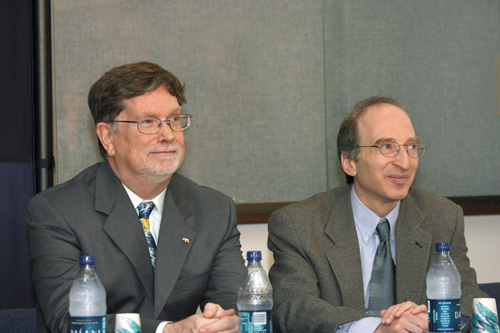 Astrophysicists George Smoot (left) and Saul Perlmutter each delivered brief remarks at the opening of the Berkeley Center for Cosmological Physics, to which both donated substantial portions of prize money won for their respective scientific discoveries.
Astrophysicists George Smoot (left) and Saul Perlmutter each delivered brief remarks at the opening of the Berkeley Center for Cosmological Physics, to which both donated substantial portions of prize money won for their respective scientific discoveries.
Photo by Robert Stokstad, Berkeley Lab
“It’s an exciting time in cosmology when we are making breakthroughs that are tremendous intellectual achievements, and I really believe we have to prepare the next generation to follow in our shoes,” said Smoot. “The BCCP has the potential to excite the public and bring in the next generation of observational cosmologists and theorists. It’s a kind of legacy, but one I can participate in, which will make coming in to work fun.”
In all, the BCCP, which is located on the UC Berkeley campus in LeConte Hall, received a total of $8.1 million in funding. In addition to the $500,000 endowment gift from Smoot, there was a $1.5 million grant from the Gordon and Betty Moore Foundation, which will provide the BCCP’s core operational funds for the next three years, plus $5.5 million in private gifts and other support for endowed chairs at the center and for postdoctoral and graduate student support.
In addition, Berkeley Lab physicist Saul Perlmutter donated a portion of his 2007 Gruber Cosmology Prize and other funds for a total gift of approximately $600,000. Perlmutter, leader of the Supernova Cosmology Project, shared this year’s Gruber Prize with Brian Schmidt, of the Australian National University and leader of the High-Z Supernova Search Team, and members of the two international teams for their respective roles in discovering a mysterious “dark energy” that’s accelerating the expansion of the universe.
“Physical space is surprisingly important,” Perlmutter told reporters at a press event to celebrate the BCCP’s opening. “It’s amazing in this over-connected world of cell phones and e-mail, how valuable personal contact remains. Just hanging out together stimulates creativity in serendipitous ways, and a chance encounter about something that might not seem worth picking up the phone for, or walking down a flight of stairs for, can become remarkably productive. You need that sense of being willing to try something and having someone be excited — and also having somebody who’s hard-nosed and able to shoot it down.”
Smoot, who shared the 2006 Nobel Prize in physics with NASA scientist John Mather for discovering the seeds of today’s galaxies in the infant universe, will serve as the BCCP’s inaugural director. One of his first orders of business will be to partner with UC Berkeley in an effort to raise another $5 million or more in endowments to ensure an ongoing center with resident postdoctoral fellows and scholars, an active visitors program, educational outreach to K-12 science teachers, and several collaborative international workshops on cosmology each year.
Already, nearly 50 scientists, from Berkeley Lab, UC Berkeley and elsewhere have joined the center, along with nearly 20 local postdoctoral fellows and a dozen graduate students. Smoot has hired two international postdoctoral fellows, who arrived this fall, and is advertising for two more for next fall. In July, the BCCP hosted its first workshop, “Physics In and Through Cosmology,” for high school teachers and students, and is planning its first annual international winter cosmology workshop, co-sponsored by the newly-created Institute of Advanced Cosmology at the National Autonomous University of Mexico, for January 2009 in Mexico.
Research at the BCCP will focus on some of cosmology’s biggest questions. Do fundamental constants, such as the gravitational and fine structure constants, vary over time? How did the phenomenon known as “inflation” take place a split-second after the Big Bang? Why did the creation of the universe favor matter over antimatter? Smoot himself will tackle cosmic strings — proposed relics of the Big Bang — and lead a search for extra dimensions beyond the well-known four, the three dimensions of space plus time.
Said Smoot, “Berkeley has a unique combination of people and projects that span from the earliest epochs to the present, both in theory and observations. Berkeley has been the pioneer and leader in this area, and could continue to be with the center in place.”
The First Year After the Prize — Travel, Travel and More Travel for Smoot in 2007
The good news is that you travel to fascinating places you might otherwise never have visited, you meet celebrities both within and outside your field you might never have met, and you receive VIP treatment everywhere you go, whether you want it or not. The bad news is that you catch a lot of colds, your dry cleaning bill is in the stratosphere, and you’ve flown on so many different airlines you can’t take advantage of all those frequent flier miles.
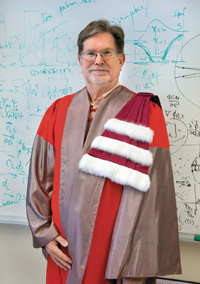 George Smoot received an honorary degree from the Université de la Mediterranée in Marseille, France, which in a tradition dating back to the medieval period, comes with an ermine sash. Photo by Roy Kaltschmidt, CSO
George Smoot received an honorary degree from the Université de la Mediterranée in Marseille, France, which in a tradition dating back to the medieval period, comes with an ermine sash. Photo by Roy Kaltschmidt, CSO
In the year since he won the Nobel Prize in physics, Smoot has logged tens of thousands of miles worth of travel, delivered scores of lectures, attended countless fundraising events, and been auctioned off for lunch dates – fetching a personal high of $6,000 for one such engagement.
“In one trip, covering a span of ten days, I went from Korea to Singapore to India to Amsterdam to London to Pisa before finally returning home,” Smoot said. “Traveling like that is disruptive both for your work and for your physical conditioning. Not only do you get driven everywhere you need to go, most of these events involve heavy rich meals, which is not conducive to staying in shape.”
In addition to the demands on his time as a new Nobel laureate and popular UC Berkeley fundraiser, Smoot also undertook extensive travel and fundraising on behalf of the Berkeley Center for Cosmological Physics (BCCP), which he was in the process of creating. The time demands became so great that in order to finish the writing of his Nobel lecture, he had to resort to still more travel, taking a two-week trip by himself to Mexico for seclusion.
Smoot made two trips to the White House where the first time he met Vice President Cheney and the second time President Bush, and one to the Senate chambers, where he learned, among other things, that Alaskan Senator Ted Stevens is a big fan of Nobel laureates. His travels took him from the hills of Hollywood where he attended the Oscar Awards, to the deserts of Dubai, where he attended the Festival of Thinkers. He just returned from Marseille, France where he received an honorary degree from the Universite de la Mediterranee, and will be headed back across the Atlantic to Cambridge University for an event with Stephen Hawking just before Christmas.
“I am definitely cutting back on the travel in 2008,” Smoot vows. “I have classes to teach and a new center to run.” — Lynn Yarris
Facilities Division Keeps Pace with Changing Lab priorities
The next few years will be a period of growth and change at Berkeley Lab, with several new buildings and scores of smaller projects in the offing. To help shepherd the Lab through this phase, Facilities Division Director Jennifer Ridgeway unveiled a reorganized division last month that is designed to provide fast, efficient, and quality service to all Lab projects, large and small.
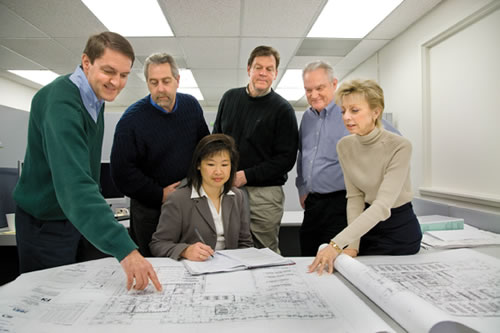 From left: Doug Lockhart, Ken Fletcher, Laura Chen, Jim Dahlgard, Steve Black, and Jennifer Ridgeway. Not shown: Jerry OHearn
From left: Doug Lockhart, Ken Fletcher, Laura Chen, Jim Dahlgard, Steve Black, and Jennifer Ridgeway. Not shown: Jerry OHearn
Photo by Roy Kaltschmidt, CSO
“The goal of the reorganization is to offer better service to the Lab, and enable it to conduct its mission of world-class science,” says Ridgeway, who took the Division’s helm in early September.
The reorganization centers around the development of several departments, each focused on a key component of maintaining the Lab’s facilities — from undertaking multimillion dollar projects to optimizing the use of office space. Together, they’ll ensure the Lab’s facilities provide the best environment for tackling today’s scientific challenges.
Specifically, Doug Lockhart heads the Development and Assurance Department, which provides key guidance during the initial stages of projects. Laura Chen heads the Planning Department, which encompasses space utilization, assisting the Associate Lab Directors in identifying space needs, master planning, and planning moves. Ken Fletcher is the acting head of the Operations Department, which oversees the Lab’s day-to-day workload of transportation, busses, cafeteria, maintenance work, painting, utilities, and other areas.
Jim Dahlgard heads the Facilities Business Department, which encompasses the Division’s IT procurement, work request center, and facility business services. Jerry Ohearn heads the Capital Projects Department, which manages projects that are slated to cost more than $1 million, and Steve Black heads the Small Projects Department, which manages projects that cost less than $1 million.
“The Lab is in a significant project-growth mode, and we’ve re-tooled the Facilities Division to better carry out these projects,” says Ridgeway.
For example, much of the work undertaken by the Facilities Division involves small projects that cost less than $1 million, such as a new roof or minor road repair. Although the Lab is very successful at managing large projects of more than $1 million, Facilities Division employees who work on small projects sometimes get sidetracked by emergencies or preventative maintenance work requests. Now, with a department dedicated to small projects, Facilities Division staff can focus solely on this work, enabling such projects to be conducted more efficiently, economically, and quickly.
“It is a very customer-oriented model,” says Ridgeway, adding that her goal is to create a facilities organization that works behind the scenes to keep the Lab running as smoothly as possible. “Our job is to be transparent: people contact us with a work request, and we get the job done at a reasonable price, in a timely manner, and at the highest quality.”
The reorganization, which went into effect Nov. 15, resulted in eight layoffs out of the 250 employees in the Facilities Division.
Building 937 Employees Moving to the Main Site
They say moving is one of the toughest tasks people undertake. Try moving 185 people to a Lab that is almost filled to capacity. Between now and the spring of 2009, the Facilities Division will do just that as it moves Lab employees who work in Building 937, which is located in downtown Berkeley, to the main site.
 Photo by Roy Kaltschmidt, CSO.
Photo by Roy Kaltschmidt, CSO.
Building 937, which some people refer to as the Burger King building because of the fast food restaurant formerly on its ground floor, currently houses employees in the Office of the Chief Financial Officer and the Information Technology Division. The building’s $1.8 million annual lease ends in April, 2009. Rather than extend the lease, Lab management has chosen to bring Lab employees up the hill. The move will both save money in the long run and foster improved collaborations among Lab employees by bringing them together.
But it’s not an easy job. The Lab has to absorb 185 new people in office space that has a one percent occupancy rate. Complicating matters, every space and floor is different, meaning a cookie-cutter approach isn’t feasible. “We don’t have a lot of wiggle room,” explains Facilities Director Jennifer Ridgeway,
To accommodate this influx of people, the Facilities Division’s Laura Chen and others mapped out a strategy that makes the best use of the Lab’s already very efficient office space. To make room, the Facilities Division will move first. They’ll move out of Building 69 and the Building 90 trailers, and consolidate into Building 76, where everyone, including the division director and department heads, will occupy cubicles. Ridgeway sees the move as an opportunity to increase collaborations within the Division.
“I want our organization under one roof,” says Ridgeway. “I don’t want to be fragmented. Much of our work needs to be communicated face-to-face within our groups.”
Next, the Office of the Chief Financial Officer will move from Building 937 to the Building 90 trailers. And the IT Division will move from Building 937 to Building 46, Building 69, and Building 90. Some Human Resources Department employees will move into Building 90, where many HR employees already work.
The shuffling isn’t over. To accommodate these moves, the Technology Transfer Department will move out of Building 90 to Building 69. And the office space in Building 90, which is mostly occupied by the Environmental Energy Technologies Division, will be modified. Throughout this transition, no new offices will be constructed, nor will any existing office spaces be dismantled. The move will be completed by April, 2009. — Dan Krotz
2008 Lab Directed Research and Development Awards Announced
More than $14 Million Earmarked for Promising Projects
Berkeley Lab Director Steven Chu announced the awards for the FY2008 Laboratory Directed Research and Development (LDRD) program (see Berkeley Lab View for December 15, 2006 for the Call for Proposals). A total of over $14.6 million in operating and capital equipment (including G&A) has been allocated to date for 69 projects from a field of 160 proposals. Of these, 33 are new and and 36 are continuation projects. The evaluations used input from divisional reviews as well as laboratory review committees.
In making the awards, Director Chu said, “We continue to be very impressed with the many creative ideas and new directions in the LDRD proposals, and feel that the program will enable a strong laboratory going forward. I also especially want to acknowledge the numerous past projects and current proposals that played a key role in our extraordinary successes in attracting new programmatic programs for our Helios initiative.”
Lead-PI |
Title |
Allocation ($K) |
Agarwal |
On-demand Overlays for Scientific Applications |
147 |
Arenholz |
Optimization of Flux Pinning Type II Superconductor Based Magnets for Soft X-ray Scattering Applications |
228 |
Arnold |
Synthetic and Electrochemical Approaches to Metal-Metal Bonds in Actinides |
161 |
Battaglia et al |
Advanced Silicon Detectors for Future Short Pulse X-ray Sources |
101 |
Bauer |
Soft Collinear Effective Theories Applied to Collider Physics |
303 |
Bell |
Structured, Adaptive Mesh Refinement Method for Multiphase Reactive Transport in Groundwater |
295 |
Bell, Pau |
Low Order Models and Numerical Methods for Computational Chemistry |
154 |
Bergman |
Conversion of Glycerol and Aromatic Compounds from Biomass to Major 3- and 6- Carbon Industrial Organic Compounds |
123 |
Berryman |
Applications of Adjoint Field Methods and Time-Reversal Data Processing to Inverse Problems in Electromagnetics, Seismics, and Ultrasonics |
153 |
Bluhm, Wilson |
Chemical Reactions at Liquid/Vapor Interfaces Probed by Photoemission Spectroscopy |
175 |
Butland |
Functional Interactomics: Integrating Physical and Functional Interaction Networks |
275 |
Christensen |
Lattice-Boltzmann Investigations of Isotopic Fractionation During Mineral Precipitation |
88 |
Clark |
New Experimental Initiative to Deduce (n,f) Cross Sections for Advanced Fuel Cycle Studies |
192 |
Collins et al |
Integrated Earth Systems Climate Modeling and Analysis |
286 |
Crooks |
Understanding the Nanothermodynamics of Molecular Machines |
187 |
Derenzo et al |
Heavy-atom Ultra-fast Scintillator for Time-Of-Flight Positron Emission Tomography |
284 |
Destaillats |
Understanding the Chemistry of Innovative Air Cleaning Technologies |
165 |
Eisen |
Computational and Experimental Testing of Methods for Binning Sequences From Metagenomic Studies |
270 |
Fawley et al |
FEL Concepts for Multiple Independent X-ray Beamlines |
325 |
Fung |
Global Methane Cycle and Climate Change |
174 |
Garcia-Sciveres |
Development of Nanowire Carpet Hybrid Pixel (NCHyP) Detectors |
161 |
Gessner |
Probing Transient Molecular Entanglement Using Femtosecond High Resolution Delayed-field Coincidence Imaging |
138 |
Guo |
Building In-situ Electronic Structure Study Capability with Photon-in/ Photon-out Soft X-ray Spectroscopy |
219 |
Hang |
Interaction of Fragile X Mental Retardation Protein with Thymine-DNA Glycosylase: Implication in the Molecular Mechanism of Fragile X Syndrome |
74 |
Hazen |
Maximizing Photosynthetic Yield by Increasing Sink Strength |
217 |
Hexemer et al |
Soft X-ray Scattering as a New Probe of Polymer Systems |
326 |
Holbrook, Banfield |
Do CRISPR Regions of Bacteria and Archaea Constitute an RNAi Based Immune System? |
250 |
Holman |
Compositional and Functional Analysis of Cell Walls During Metal-Bacterial Actions |
173 |
Jansson |
Microbiomics of Complex Microbial Communities in Environmental Samples |
233 |
Javey |
Integration of Synthetic Nano-Materials for High Speed, Robust, and Flexible Circuitry |
89 |
Jerome |
Transport in Thin Polymer Films |
136 |
Ji |
Ultra-compact Field Desorption Neutron Source for Cancer Research |
252 |
Kirchstetter |
Soot in Ice: Does Soot Enhance the Melting of Ice? |
177 |
Klein |
Development of a 100 km3 Neutrino Detector for Extremely High Energy Neutrinos |
235 |
Kohwi-Shigematsu |
Genome Organizer in Carcinogenesis |
269 |
Lee (S-W) |
Fabrication of Photovoltaic Devices Using Nano-Sructured Biomaterials |
138 |
Lesko, Wang |
Physics Detector and Sensor Technologies Applied to Geological and Geophysical Applications at DUSEL |
295 |
Levine |
China’s Energy Future: Changes in Energy Intensity |
329 |
Liphardt et al |
Light-Boosted Fermentation in the Yeast Saccharomyces Cervisiae |
141 |
Long |
Conducting Metal-Organic Frameworks |
136 |
Lunden |
Novel Techniques to Characterize Secondary Organic Aerosols Formed From Gas-phase Volatile Organic Compounds Emitted From Biogenic Sources |
132 |
Markowitz et al |
Integrated Microbial Community Genomes Data Management System |
330 |
McMahon et al |
Integrated Decision Support Tool for Joint Optimal Control of Energy and Water Systems under Uncertainty |
296 |
Nakagawa |
New Technology for Permeability Enhancement for Natural Gas Extraction in Tight Reservoirs |
148 |
Oldenburg |
Coupled Modeling of Hydrology, Nutrient Cycling, and Vegetation: Applications to Water Quality and Water Balance Applied to the Central Valley |
128 |
Perry |
Design and Properties of Materials Involving Elements with High Neutron Cross-Sections That Are Useful in Neutron Detection and Related Neutron Technologies |
289 |
Rotem, Otoo |
Energy-Smart Disk-Based Mass Storage System |
244 |
Rotenberg |
Carbon-Based Nanostructures as a Prototype for New Electronics |
282 |
Schaffer |
Cooperation of Biochemical and Mechanical Signals in Regulating Cell Fate Decisions During Tissue Morphogenesis |
268 |
Schenkel |
Quantum Information Science with Integrated Color Centers in Diamond |
132 |
Schlegel |
Baryon Oscillations and Dark Energy: Prototyping Instruments |
289 |
Schroeder et al |
Coupled Process Models and Monitoring for Advanced Nuclear Fuel Cycles |
500 |
Shalf et al |
Holistic Approach to Energy Efficient Computing Architecture |
215 |
Shapiro et al |
Development of a Laser Goniometer for X-ray and Electron Diffraction Microscopy |
109 |
Sichtermann |
Hyperons in Polarized Proton Collisions and the Origin of the Nucleon Spin |
154 |
Siddiqi |
Quantifying the Quantum Backaction of a Non-Linear Dispersive Measurement |
99 |
Skinner |
Integrated Performance Monitoring of Grid and HPC Workloads |
137 |
Smoot, Leauthaud |
Decoding Dark Energy with Weak Gravitational Lensing |
219 |
Stamper-Kurn |
Two-Element Ultracold-Atom Quantum Simulator of Materials |
122 |
Toste |
Metal Nitrosyl Complexes and Catalytic C-H Bond Functionalization |
153 |
Toth et al |
Experimental Demonstration of a Laser-Plasma-Accelerator Driven Free-Electron Laser |
386 |
Vay et al |
Lorentz Compaction of Scales for Ultra-efficient Simulation of Advanced Accelerators (and other systems) |
202 |
Vetter |
Conceptual Study for a Novel Nuclear Astrophysics Accelerator Capability |
216 |
Wan et al |
High Brightness Photocathodes as Electron Sources for FELs |
353 |
Wilkening |
Extended First Order System Least Squares Finite Elements |
64 |
Wu |
Transition-Metal-Doped GeTe Nanowires as a Single-Phase Multiferroic System |
134 |
Wyrobek |
Expression Profiling of Radiation and Cancer Susceptibility Genes |
429 |
Yashchuk |
Ultra-high Resolution Optics for Soft X-ray Inelastic Scattering |
171 |
Zholents et al |
Emittance Manipulation and Beam Conditioning for FEL’s |
366 |
|
Total Allocations |
$14,641 |
Berkeley Lab Science Roundup
Fall into the Gap: A Step Towards Graphene Electronics
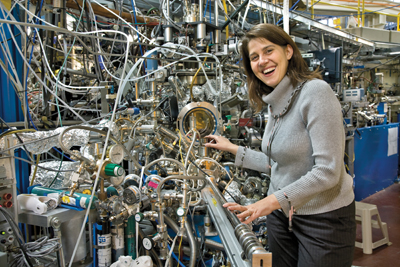 Alessandra Lanzara at ALS beamline 12.0.1, where she found graphene's first reported band gap. Photo by Roy Kaltschmidt, CSO
Alessandra Lanzara at ALS beamline 12.0.1, where she found graphene's first reported band gap. Photo by Roy Kaltschmidt, CSO
They said graphene couldn't exist. Then researchers actually made it — a single sheet of carbon atoms like an unrolled carbon nanotube in which electrons flow freely, promising a new generation of faster, smaller, cheaper, more durable computer chips. Only one catch — graphene lacks an energy gap, the band gap that makes it possible to turn semiconductors into transistors. Proposals to open a graphene gap have all required complex engineering of the gossamer carbon network. Then a team led by Alessandra Lanzara of MSD and including MSD's Shuyn Zhou, Alexei Federov of the ALS, and colleagues from UC Berkeley, Georgia Tech, the University of Madrid, and Boston University, found that growing a sheet of graphene on a silicon carbide substrate opens a 0.26 electron-volt gap when the graphene–substrate interaction breaks the sublattice symmetry — a promising direction for band gap engineering of graphene. The work appeared in the November, 2007 issue of Nature Materials Insight.
Hot Wet Polymers
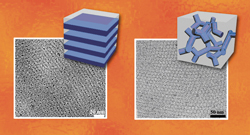
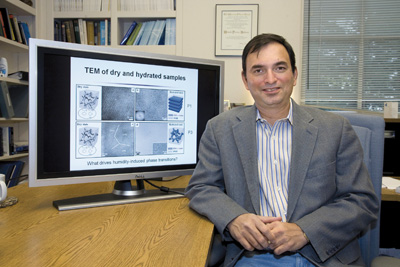 Top, microscope images of water-filled channels in two block copolymer membranes; schematics show the architecture of the nanometer-scale channels. Below, Nitash Balsara.
Top, microscope images of water-filled channels in two block copolymer membranes; schematics show the architecture of the nanometer-scale channels. Below, Nitash Balsara.
Copolymer membranes that get wetter as the surrounding air gets hotter have been developed by Nitash Balsara of the Materials Sciences Division, leading a team that includes fellow MSD members Moon Jeong Park, Enrique Gomez, and Andrew Minor, plus Ken Downing of Life Sciences, Adam Weber of the Environmental Energy Technologies Division, and colleagues from NIST and Argonne National Laboratory. Polymer electrolyte fuel cells show promise as a nonpolluting power source for cars and other applications, but when they get hot they lose water and suffer a decrease in proton conductivity. The unlikely new materials could change that. Made from nanoscale layers of two kinds of polymer, one that repels water and another that attracts it, the copolymers are riddled with hydrophilic channels. When channels measure less than five nanometers across, water uptake increases as the temperature rises, and proton conductivity increases at the same time — ideal for fuel cells. The oddball polymers are described in the Oct. 26 online version of Nano Letters.
More Porous Polymers
Another way nano-openings in polymers could help advance the energy frontier is by boosting the ability of fuel cells to store hydrogen, thus overcoming the problems associated with compressing and liquefying the gas. Frantisek (Frank) Svec of MSD, working with MSD’s Jean Fréchet and Jonathan Germain of UC Berkeley, has come up with a potential adsorbent for hydrogen made of “hypercrosslinked polyanilines with nanoporous structure and high surface area.” Polyanilines are rod-shaped conducting polymers, and these polyanilines have high affinity for hydrogen. Hypercrosslinking them creates a mesh-like structure that keeps the polymer chains apart, leaving a material that’s riddled with nanometer-sized pores and has an enormous surface area for its diminutive bulk — up to eight times higher than previous porous polyanilines. More surface grabs more hydrogen, potentially providing a solution to the problem of hydrogen storage in fuel tanks. The researchers published their work online Oct. 18 in the Journal of Materials Chemistry.
Not Your Great-Grandfather’s Fruit Fly
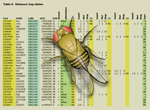 Drosophila melanogaster has been used to study genetics for over a century.
Drosophila melanogaster has been used to study genetics for over a century.
Drosophila melanogaster led genetic research for over a century, the model organism that pioneered many of the basic principles governing animal development and population biology and provided the first-sequenced whole genome of a complex animal. But Drosophila is not the only species of fruit fly, and now members of Harvard’s FlyBase and the Berkeley Drosophila Genome Project, including the Life Sciences Division’s Joseph Carlson and Susan Celniker, have sequenced, assembled, and annotated the genomes of 12 different Drosophila species to discover new functional elements in the genome. In addition to shedding new light on the evolution of genes and chromosomes and how they relate to speciation and adaptation in Drosophila, a major goal was to develop general methods for discovering functional elements and their implications for vertebrate studies. The major research appeared in the Nov. 8 issue of Nature.
Consumer Chips on the Cutting Edge



The monolithic pixel sensor test chip packs 22,500 pixels onto an SOI chip just two millimeters square. Next, Marco Battaglia (left) and Peter Denes
A silicon-on-insulator (SOI) chip puts a layer of electronics on top of a silicon insulator on top of a substrate to considerably increase the speed of microprocessors while drastically cutting power consumption. SOI chips were developed for consumer applications like cell phones and digital cameras, but when Japan’s High Energy Accelerator Research Organization, KEK, and supplier OKI Electric Industries invited researchers to submit ideas for scientific applications — offering to manufacture the designs for free — Marco Battaglia of the Physics Division and Peter Denes of Engineering jumped at the chance. Their design for a fully depleted, monolithic pixel sensor caps each pixel with its own electronics to save precious readout time. A team including Devis Contarato, Piero Giubilato, and Lindsay Glesener of Physics and Chinh Vu of Engineering, plus Padua University colleague Dario Bisello, successfully tested the chip with the Advanced Light Source’s linac; a new design is in the works. The work appeared online Oct. 6 in Nuclear Instruments and Methods in Physics Research.
Targeting Topo II
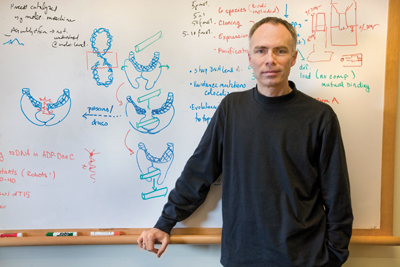 James Berger
James Berger
The veil has finally been lifted on an enzyme that’s critical to DNA transcription and replication, and is a prime target of antibacterial and anticancer drugs. Working at the Advanced Light Source (ALS), James Berger, of the Physical Biosciences Division, has produced the first three-dimensional structural images of a DNA-bound Type II topoisomerase (topo II) that’s responsible for untangling coiled strands of the chromosome during cell division.
“Topo II has been called nature’s magician because it literally can move one DNA segment through another,” said Berger. “The enzyme cleaves a double-stranded DNA, passes a second duplex through the break, and then immediately repairs the broken strands.”
Preventing topo II from disentangling a cell’s DNA is fatal to the cell. This first-ever structural image of topo II should help in the development of future antibacterial and anticancer drugs that are even more effective at crippling it and carry fewer potential side effects.
Helium Isotopes at the Surface are Clues to New Sources of Geothermal Energy Deep in the Earth
Sometimes by drilling bore holes, sometimes by sampling geysers and other surface fluids, geochemist Mack Kennedy of the Earth Sciences Division has long used elements that percolate up from the depths of the Earth to find out what’s going on with the planet’s restless geology. Recently Kennedy and colleague Matthijs van Soest of Arizona State University discovered a new way to use surface fluids to find potential sources of geothermal energy.
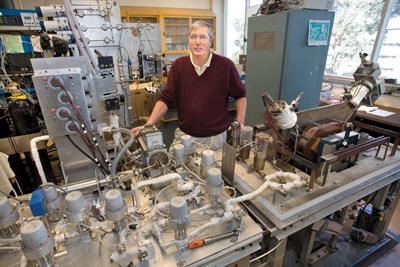 Mack Kennedy with the mass spectrometer he used to measure isotopes in samples from the Basin and Range.
Mack Kennedy with the mass spectrometer he used to measure isotopes in samples from the Basin and Range.
Most developed geothermal energy, like The Geysers in Northern California, comes from volcanic regions. But the potential resources identified by Kennedy and van Soest, his former postdoc, are in regions far from current or recent volcanic activity.
“A good geothermal energy source has three basic requirements: a high thermal gradient — which means accessible hot rock — plus a rechargeable reservoir fluid, usually water, and finally, deep permeable pathways for the fluid to circulate through the hot rock,” says Kennedy. “We believe we have found a way to map and quantify zones of permeability deep in the lower crust that result not from volcanic activity but from tectonic activity, the movement of pieces of the Earth’s crust.”
Their discovery emerged from a DOE-sponsored survey in which Kennedy and van Soest measured ratios of helium isotopes across the northern Basin and Range, including parts of California, Nevada, Oregon, Idaho, and Utah. Earth’s deep mantle retains a high proportion of primordial helium-three left over from the formation of the solar system, while the crust is rich in radioactive elements that decay by emitting alpha particles, helium-four nuclei. A high ratio of helium-three to helium-four in a fluid sample indicates that much of the fluid came from the mantle.
When Kennedy and van Soest found high ratios in places far from volcanism, they knew that mantle fluids must be penetrating the ductile boundary by means other than the intrusion of magma. Geology was the clue. In the Basin and Range, crustal spreading by east-to-west extension has separated mountain ranges by blocks of crust which have sunk and become filled with sediment.
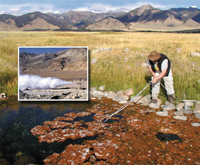 Matthijs van Soest collects samples of surface fluids in the northern Basin and Range.
Matthijs van Soest collects samples of surface fluids in the northern Basin and Range.
Fault planes between the uprisen range blocks and the sunken basin blocks form high-angle pathways deep down into the brittle upper crust, which is some of the thinnest in the world, resulting in unusually high thermal gradients.
As the fault planes approach the ductile lower crust they are deflected and become more horizontal; Kennedy thinks permeable passageways emanate from these deep, horizontally-trending faults, penetrating the ductile boundary into the mantle, without the assistance of volcanic activity. The samples the researchers collected on the surface gave them a window into the structure of the rocks far below, with no need to drill.
“We have never seen such a clear correlation of surface geochemical signals with tectonic activity, nor have we ever been able to quantify deep permeability from surface measurements of any kind,” says Kennedy.
Kennedy and van Soest reported their findings in the Nov. 30, issue of Science.
People, Awards, and Honors

Materials Researcher Honored by Society
The Materials Research Society (MRS) has awarded Ramamoorthy Ramesh of the Lab’s Materials Sciences Division its 2007 Turnbull Lectureship for his research on oxides and his “enthusiasm and leadership in conveying the excitement of this field.” A professor in UC Berkeley’s Materials Science and Engineering Department and one of the most cited researchers in physics, Ramesh did pioneering research on high-temperature superconductors at Berkeley Lab. He received the award, which includes $5,000 and a plaque, at the Nov. 27 MRS fall meeting, where he delivered the Turnbull Lecture, “Whither Oxide Electronics.”
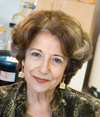
Breast Cancer Expert Gets International Award
The French National Institute for Health and Medical Research (INSERM), a public scientific and technological organization, has given Berkeley Lab life scientist Mina Bissell its “Annual International Award” for an outstanding individual in science, medicine or public health that has motivated and reinforced international exchange and collaboration in terms of innovation and improvement of excellence and the transfer of fundamental research to clinical research and public health. Bissell was recognized for her “three decades of creativity, focus and tenacity to uncover the essential role of cell and matrix topology in carcinogenesis with recent elucidation of the mechanisms by which tissue geometry can control branching morphogenesis by defining the local microenvironment. Your work has already significantly benefited sciences and medicine and grows in ever increasing directions.”

Earth Scientist Chosen For Diablo Canyon Panel
State Attorney General Jerry Brown recently appointed Robert Budnitz, with Berkeley Lab’s Earth Sciences Division, to a three-year term on the Diablo Canyon Independent Safety Committee (DCISC). The DCISC was established in 1986 under the auspices of the California Public Utilities Commission as an independent committee charged with reviewing the safety of PG&E’s Diablo Canyon Nuclear Power Plant. The DCISC consists of three members, one each appointed by the Governor, the Attorney General, and the California Energy Commission. Budnitz is an expert in nuclear safety engineering.
Researchers Receive Physics Fellowships
Four Berkeley Lab scientists have been elected American Physical Society Fellows. They include Michael Crommie (Materials Sciences) for his application of scanning tunneling microscopy, atomic and molecular manipulation, and scanning tunneling spectroscopy to the electronic and magnetic properties of surface-based nanostructures; Miguel Furman (Accelerator & Fusion Research) for his pioneering development and application of simulation tools for the beam-beam and electron cloud effects in colliders and storage rings; Augusto Macchiavelli (Nuclear Science) for his essential role in the development and use of Gammasphere and for his seminal contributions to the understanding of the phenomenon of magnetic rotation and to the study of neutron-proton pairing correlations; and Max Zolotorev (Accelerator & Fusion Research) for the invention of methods to generate ultra-cold and ultra-fast sources of electron and ion beams using lasers and optical techniques.
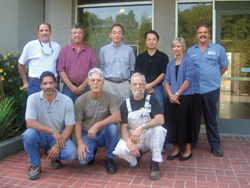
Champions of Safety ‘Spot’ Winners Honored
In recognition of their efforts to make Berkeley Lab a safer place, 20 employees received awards from Director Steve Chu. The Safety Spot Awards program, implemented by the Environment, Health and Safety Divi-sion, seeks to encourage the use of safe practices by staff. The winners include Roxanne Clark (Computing Sciences), Wayne Greenway (Engineering), Alan Poon (Nuclear Science), James Smithwick (Infor-mation Technologies), and the following Facilities Division employees: Michael Crofoot, Andrew Tyrrell, Julian Aki, Harry Bash, Rod Bennett, Tom Bennett, Steve Campos, Don Decuir, Richard Doty, Warren Elliot, Joseph Herrera, Lonnie Lafon, Gerald Martin, Blair Mordecai, Jimmie Nez, and John Souza.